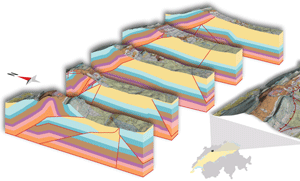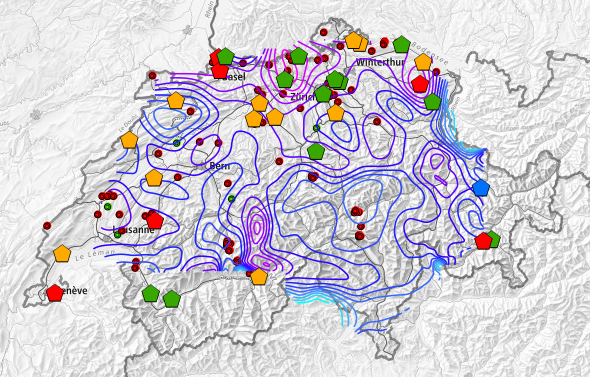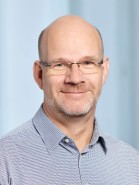New models of Switzerland's subsurface
February 2018 - by Thomas Driesner
Most people probably struggle to imagine what Switzerland's subsurface looks like at depths of hundreds or thousands of metres. Yet it contains some key resources. Groundwater, gravel and sand have long been exploited, but deeper underground there is much untapped potential in the form of geothermal heat and porous rock layers. Computer models make the subsurface visible, enabling us to plan uses of geo-energies.
As a geologist, I am always fascinated by how much the subsurface contributes to our daily lives: from the groundwater we drink, to the oil and gas that power our vehicles and heating systems, to metals that play such an essential role in products as diverse as bicycles, smartphones and heating pipes. But also building materials like sand and gravel or the raw materials for concrete and cement come from the ground. Although no metal ore, oil or gas are mined in Switzerland, there is great hidden potential in our subsurface.
Using and storing energy
For example, geothermal heat is available everywhere, and the deeper we drill to access it, the more the energy yield increases. Naturally, we would like to tap into this potential to use it for our heating systems and to generate power. However, this is difficult to do, for the process of extracting geothermal energy from a depth of four to five kilometres in a precise and efficient manner is still relatively untried. Which is why researchers around the world, including some at the SCCER-SoE, are working to develop it.
Another exciting domain where the geological underground could play a major role in establishing green energy technologies is intermediate energy storage. In many cases, energy accumulates exactly when we do not need it, at the height of summer for example. Counteracting this problem is the goal of the GEothermie 2020 project currently under way in Geneva, with scientific support from the SCCER-SoE: in future summers, part of the water that is heated by the excess heat from a waste incineration plant shall be stored in porous rock layers deep underground instead of feeding it into the local district heating system. Only when the cold winter comes will it be pumped back up to the surface and piped to the several thousand households.
Making use of existing data
The dependability of planned geothermal energy projects hinges on having an accurate picture of the geological underground. And the best way to gain such an overview is by drilling down thousands of metres. However, this is expensive, so boreholes are sunk primarily in regions with extensive oil and gas deposits, such as Holland or northern Germany. As far as we currently know, Switzerland has no such deposits, so up to now little deep drilling has taken place. One exception, though, is the set of around a dozen boreholes sunk by Nagra in the search for suitable sites for radioactive waste repositories. Additional information stems from seismic surveys in which the path taken by sound waves through the subsurface is tracked and analysed in order to constrain the position of various rock layers.
One of the SCCER-SoE's tasks is to use such drilling and seismic data to create a virtual 3D model of Switzerland's subsurface. The organisation in charge of this undertaking is the Swiss Federal Office of Topography swisstopo, which together with its regional partners (mainly universities) collates and analyses the data, which include temperature measurements from deep drilling and more superficial boreholes (just a few hundred metres deep). These data help to provide a clearer picture of temperature distribution in the subsurface. Up to now, there was no way of doing this, the only guide being a geothermal surface heat flow map. The new 3D model will shortly become available online for project planners and all other interested parties via swisstopo. With this information about deep rock layers and temperatures, specialists can assess the best locations for geothermal energy projects.
Geological data viewer of swisstopo
Layers: deep geothermal projects (pentagons), wells deeper than 500 m (circles), heat flux (curves).
Modelling processes
However, although gaining a picture of the underground is important, it is equally essential to find out whether the intended technologies actually work there. Does the hot water stay in the desired place after being stored or does it flow somewhere else? Does it cool too quickly when coming into contact with the rock? Do the minerals in the rock dissolve in the hot water and then precipitate again during the cooling process? Does injecting the water trigger ground movements? Computer programs that can be used to model these processes play a key role in answering these questions. Researchers from the SCCER-SoE are currently refining such programs. In the future, for example, they should be able to directly input the new models of Switzerland's subsurface and calculate whether - and, if so, how - geothermal energy technology can be made to work there. Research on such modelling procedures is currently being carried out in a number of countries. Within the framework of the International Partnership for Geothermal Technology (IPGT), our experts collaborate with colleagues from Australia, Iceland, New Zealand and the USA.
Probing the future
When I was a student, I could not have conceived of such research. Back then, earth sciences were considered rather old-fashioned and barely relevant for technological innovation. But the situation has since changed drastically, and today exciting future challenges associated with finding a sustainable, environmentally friendly energy supply are key fields of research in our academic domain. I am pleased for our students that these topics are now so strongly represented at ETH Zurich and other Swiss universities.
Author
Until the end of 2017, Professor Thomas Driesner from the Institute of Geochemistry and Petrology ETH Zurich was the SCCER-SoE's geo energies project coordinator (WP1). Besides developing modelling programs, he also carries out research into natural geothermal systems (e.g. in Iceland) and how copper and gold ore deposits form around volcanoes.



